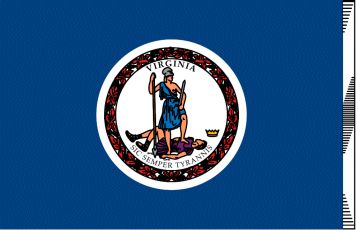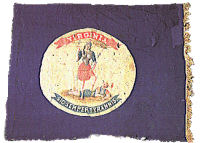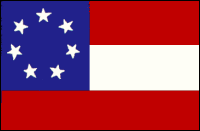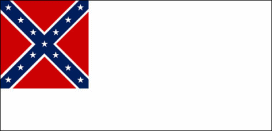The Virginia State Flag
Though flags similar to Virginia's current flag had flown in the State since the 1830s, Virginia did not adopt an official flag until after it had seceded from the Union in 1861. The Flag of the Commonwealth was adopted on April 30, 1861 almost two weeks after Virginia voted, on April 17, 1861, to repeal its 1788 ratification of the Constitution of the United States. The Virginia Flag of the Commonwealth displays the State Seal of Virginia centered on a blue field (background).
From January through mid-April, delegates to the 1861 Virginia Convention staved off efforts to vote Virginia out of the Union but their efforts fell short on April 17, perhaps assisted by the announcement that President Abraham Lincoln had just called for 75,000 volunteers for the Union army. In a vote adopting "An Ordinance to repeal the ratification of the Constitution of the United States of America, by the State of Virginia, and to resume all the rights and powers granted under said Constitution," Virginia declared its sovereignty and opened the way for the Commonwealth to join the Confederate States of America (CSA).
On April 30, 1861, a flag very similar to the current flag was adopted when Ordinance No. 30 was embraced by the Virginia Convention of 1861 -- The Secession Convention. This ordinance was ratified by a vote of the electorate in May.
No. 33 -- An ORDINANCE to establish a Flag for this Commonwealth
Be it ordained by the convention of the commonwealth of Virginia, that the flag of this commonwealth shall hereafter be made of bunting, which shall be a deep blue field with a circle of white in the centre, upon which shall be painted or embroidered, to show on both sides alike, the coat of arms of the state, as described by the convention of seventeen hundred and seventy-six, for one side of the seal of state, to wit:
"Virtus, the genius of the commonwealth, dressed like an Amazon, resting on a spear with one hand, and holding a sword in other, and treading on tyranny, represented by a man prostrate, a crown fallen from his head, a broken chain in his left hand and a scourge in his right. In the exergon the word Virginia over the head of Virtus, and underneath the words "Sic Semper Tyrannis."
This flag shall be known and respected as the flag of Virginia.
The governor shall regulate the size and dimensions of the flag proper for forts, arsenals and public buildings, for ships of war and merchant marine, for troops in the field, respectively, and for any other purpose, according to his discretion; which regulations shall be published and proclaimed by him as occasion may require.
This ordinance shall take effect from its passage.
Virginia joined the CSA in 1861. During the Civil War Virginia regiments flew the newly adopted Flag of the Commonwealth along with the two national flags of the Confederate States of America.
The First National Flag (Stars and Bars) was used from 1861 to 1863. Concern over the similarity of the Confederate flag to the flag of the United States led to a change in design and to design of the Second National Flag. Difficulty distinguishing the Stars and Bars from the Stars and Stripes from a distance, particularly in battle, was one reason given for the change.
Hoping to find replacements for the Stars and Bars that had created confusion in the field at the battle of Manassas, CSA General Joseph E. Johnston asked states to provide state banners for their military units in the field. North Carolina and Virginia responded to his request. Virginia's Governor Letcher delegated the responsibility for furnishing the Flag of the Commonwealth to his Secretary of State, George Mumford. The actual production of the flags was delegated to Mumford's family, his six daughters. They produced over 60 flags.
The Second National Flag (Stainless Banner) was used beginning in 1863. As with the Stars and Bars, some saw shortcomings with the Stainless Banner. Though the official specification for the flag detailed in the Flag Act of 1863 described a flag whose length was twice as long as its width, the flag was often shortened to a more traditional dimension. Some have said this was to prevent the white flag for being mistaken for a flag of surrender.
In the late months of the Civil War, on March 4, 1865, CSA President Jefferson Davis signed a bill creating a third design for the Confederate National Flag, but it is not certain how many of these flags were made or if any were actually raised. This third flag's width was designated to be two thirds its length; a more traditional shape than the Stainless Banner. The field remained white but the outer half of the field consisted of a vertical red band.
As for the Flag of the Commonwealth adopted in 1861, some minor changes were made in the first half of the 20th century.
- In 1930 the white fringe was added to the fly.
- In 1931 the "ornamental border" of the seal was more precisely defined as a wreath of Virginia creeper.
- On March 16, 1949, exact colors were assigned to the various design elements.
Virginia Flag Law
The following information was excerpted from the Code of Virginia, Title 1, Chapter 5.
Title 1 - GENERAL PROVISIONS.
Chapter 5 - Emblems
§ 1-506. Flag of the Commonwealth.
The flag of the Commonwealth shall be a deep blue field, with a circular white centre of the same material. Upon this circle shall be painted or embroidered, to show on both sides alike, the coat of arms of the Commonwealth, as described in § 1-500 for the obverse of the great seal of the Commonwealth; and there may be a white fringe on the outer edge, furthest from the flagstaff. This shall be known and respected as the flag of the Commonwealth.
(Code 1950, § 7-32; 1966, c. 102, § 7.1-32; 2005, c. 839.)
§ 1-507. Governor to prescribe size of flag.
The Governor shall regulate the size and dimensions of the flag proper for forts, arsenals and public buildings, for ships-of-war and merchant marine, for troops in the field, respectively, and for any other purpose, according to his discretion by proclamation.
(Code 1950, § 7-33; 1966, c. 102, § 7.1-33; 2005, c. 839.)
§ 1-508. Director of General Services to have available flags of the Commonwealth for sale.
The Director of the Department of General Services shall have available at all times flags of the Commonwealth, to be offered for sale to the public in such manner as the Director may determine.
Such flags shall be of good quality, shall conform to the specifications prescribed in § 1-506, and shall be offered in the various sizes prescribed by the Governor pursuant to § 1-507.
The prices to be charged for such flags shall be at cost as determined by the Director.
(Code 1950, § 7-33.1; 1958, c. 553; 1960, c. 347; 1966, c. 102, § 7.1-34; 2005, c. 839.)
§ 1-509. When flag to be suspended over Capitol.
During the sessions of either house of the General Assembly the flag of the Commonwealth shall be kept raised over the respective chambers of the Capitol, or other place of session, if practicable, as directed by the Director of the Department of General Services and the Chief of the Virginia Capitol Police in consultation with the Clerk of the House of Delegates and the Clerk of the Senate.
(Code 1950, § 7-34; 1966, c. 102, § 7.1-35; 1970, c. 561; 2005, c. 839.)
Source: The Virginia General Assembly:Legislative Information System, Code of Virginia, , January 30, 2008.
Source: Flags Of The Confederacy, Virginia, , January 30, 2008.
Source: Flags of the Fifty States and Their Incredible Histories: The Complete Guide to America's Most Powerful Symbols by Randy Howe. The Lyons Press; First edition edition (November 1, 2002).
Source: State Names, Seals, Flags and Symbols: A Historical Guide Third Edition, Revised and Expanded by Benjamin F. Shearer and Barbara S. Shearer. Greenwood Press; 3 Sub edition (October 30, 2001).
Source: State Names, Flags, Seals, Songs, Birds, Flowers, and Other Symbols by George Earlie Shankle. Reprint Services Corp; Revised edition (June 1971).
Additional Information
Virginia (U.S.):
FOTW "Flags of the World" Web Site.
Flags of the Confederacy: Virginia:
FOTC (Flags Of The Confederacy) is a site devoted to Confederate vexillology. Here you can read about the numerous flags of the government and armed forces of the Confederate States of America, and view many images of those flags..
State Flags:
Complete list of state flags with links to large pictures and images suitable for coloring.
Flag Terminology:
The parts of a flag and terms associated with its design.
Visit Our Flag Shop:
Purchase all kinds of flags and banners, lapel pins, 50 state flag sets, decals, patches, college banners at the Flag Shop.
Flags of the Fifty States and their Incredible Histories:
A complete guide to America's most powerful symbols by Randy Howe.
How Proudly They Wave: Flags of the Fifty States:
This book, by Rita D. Haban, is geared toward younger readers. |






